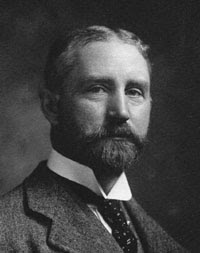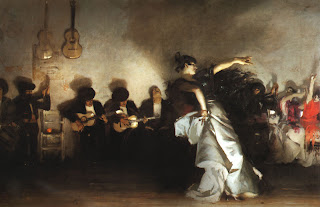During the first 35 years of its existence, the Massachusetts Institute of Technology was headed by its founder, William Barton Rogers, former Civil War General Francis A. Walker, and two MIT professors. The selection of Henry Smith Pritchett to become the Institute's fifth president in 1900 signaled a shift in direction.
Pritchett held a doctorate in astronomy from the University of Munich and had demonstrated both his academic and administrative strengths. He had spent 17 years in academia, and three years in an impressive stint as superintendent of the US Coast and Geodetic Survey where he developed a close relationship with President McKinley. He was young, bright, energetic, well-connected, handsome, socially adept, and popular, and he arrived at MIT in the summer of 1900 with high hopes for his future there.
Despite his achievements at MIT, Pritchett's career as a college president ended up being a brief six years in duration. In 1904, Pritchett proposed what was essentially a loose merger between Harvard and MIT. Under this plan, Harvard's Lawrence Scientific School would become part of the Institute, the Institute would move to Cambridge under the aegis of Harvard (on the site currently occupied by the Harvard Business School), and Pritchett would retain the presidency and a certain amount of independence for the Institute. MIT alumni and faculty were largely opposed, but the real fly in the ointment was the unwillingness of the Massachusetts legislature to allow the sale of Tech's Boston property on Boylston Street. Pritchett resigned the presidency of MIT after the deal fell through, and left Boston in 1906 to head the brand new Carnegie Foundation for the Advancement of Teaching.
Pritchett is largely a forgotten man in Boston and Cambridge but his influence on education and educators in this mecca of US education was enormous.
MIT
His first achievement was his work at MIT. Dr. Robert Payne Bigelow, a professor there from 1893-1933, says that Pritchett's administration was "a turning point in the history of the Institute."
Pritchett’s primary concern was for student welfare—academic, social, and physical. He encouraged students to seek advice from him, he established a department of physical education, he turned the culture on its head by having top faculty teach freshmen, he cultivated relations with the staff and increased their salaries, he sent professors to visit laboratories abroad, and he developed the departments of chemical engineering and applied electricity. Bigelow goes on: “I have naturally watched with much interest its growth from the turning point under Pritchett to the magnificent institution it is today. I have seen practically all of Pritchett’s dreams come true.”
Franklin Union
Pritchett was a great supporter of other forms of industrial education. In 1904, as a trustee of Boston's Franklin Foundation (the accumulated value of a thousand pound legacy bequeathed to the city by Benjamin Franklin), he was instrumental in getting Andrew Carnegie to match the $408,000 then in the fund. This created a large enough endowment to found an evening training school to be called the Franklin Union. The conditions attached to Carnegie's gift were two: that the school be similar to the Cooper Union and NYC's Mechanics' and Tradesmen's School, and that the City of Boston provide the land. Both conidtions were met, and the school opened in its new building in Boston in the fall of 1908.
Today the Franklin Union has become the Benjamin Franklin Institute of Technology, offering nine associate's degrees in engineering and industrial technology, a bachelor's degree in automotive technology, and a variety of certificate programs.
Lowell Institute
During Pritchett's tenure as MIT president, he was asked by Abbott Lawrence Lowell, a Harvard professor (and later to be Harvard president), MIT trustee, and trustee of the Lowell Institute to find a man who could plan and conduct courses aimed at training industrial foremen. The Lowell Institute had grown out of a bequest by Lowell's grandfather, textile merchant John Lowell, to offer what were to become hugely popular free public lectures to the citizens of Boston. The new undertaking would be a joint venture by the Lowell Institute and MIT. Pritchett selected Dr. Charles F. Park to be the director of the Lowell Institute School for Industrial Foremen, a move to which Lowell credited the successful launch of the new school. Since 1996, the Lowell Institute School has been a part of the Northeastern University College of Professional Studies, offering bachelor's and associate degrees in engineering technologies.
TIAA-CREF
Pritchett's final contribution, this time to educators, was not limited to the Boston area. As President of the brand new Carnegie Foundation for the Advancement of Teaching, he was charged with developing a plan to provide pensions for retired faculty members. The Trustees had originally hoped to fund free pensions but it became apparent to them that the endowment was not large enough for this purpose. Pritchett proposed a pension fund partly funded by the institutions and the faculty members themselves. This was named the Teachers Insurance and Annuity Association (now better known as part of TIAA-CREF), and Pritchett served as its President from 1918-1930. (TIAA-CREF today holds over $450 billion in assets.)
NOTE: The Lowell Institute was also the founder of Boston's public radio/TV station WGBH in 1951. In 1946, the Institute had begun broadcasting its lectures on the radio, and the Lowell Institute Cooperative Broadcasting Council was the licensee for one of the newly created FM radio channels in April 1951.
Illustration Credits and References
Photo of Henry S. Pritchett from the MIT History website.
1903 photo of the Boylston street MIT campus from Hello Boston History Photo Archive.
Information about Henry Pritchett's career largely obtained from Henry S. Pritchett: A Biography by Abraham Flexner, New York: Columbia University Press, 1943.
Tuesday, October 4, 2011
Wednesday, July 20, 2011
El Jaleo, Isabella Stewart Gardner, and TJ Coolidge
The painting El Jaleo hangs on the first floor of the Isabella Stewart Gardner museum in a space and setting designed by Isabella to truly showcase this huge (11 feet wide!) and beautiful work by John Singer Sargent. I have admired it numerous times; when I taught at Simmons College (located right across Palace Road from the Gardner) I frequently ate lunch in the lovely little Gardner café, and always stopped for a few moments on my way to lunch to study this painting.
But I just learned today that two of my favorite women from 1905 Boston, Eleonora Randolph Sears and Isabella herself, had a connection through this painting. (Click here to read my previous post about Eleonora.)
Eleo's grandfather, Thomas Jefferson Coolidge, had seen Sargent's talent early on and purchased the painting in 1882, shortly after it was first exhibited by the 26-year-old painter. Isabella, who was a friend (and a cousin by marriage) of Eleo's mother (and TJ's daughter), Nora Coolidge Sears, coveted the painting and tried to buy it from Coolidge for 30 years. According to Eleo biographer Peggy Miller Franck, Coolidge put her off with vague assurances that he would sell it to her one day.
In 1914, most likely worn down after the death of both Nora and her brother in 1912, TJ agreed to loan El Jaleo to ISG for an exhibition she was planning.
Isabella had spent 30 years imagining how to display the painting for maximum effect. In 1914 she directed some major remodeling in Fenway Court (now the Gardner Museum) and constructed a new gallery for the painting, set off by a Moorish stone arch edged with mirrors, and with a display of musical instruments and a row of footlights on the floor in front of the painting. Frank says that when "T.J. saw the showcase that Belle had created, he gave the painting to her."
References
Information from Peggy Miller Franck's Prides Crossing: The Unbridled Life and Impatient Times of Eleonora Sears, Beverly: Commonwealth Editions, 2009.
But I just learned today that two of my favorite women from 1905 Boston, Eleonora Randolph Sears and Isabella herself, had a connection through this painting. (Click here to read my previous post about Eleonora.)
Eleo's grandfather, Thomas Jefferson Coolidge, had seen Sargent's talent early on and purchased the painting in 1882, shortly after it was first exhibited by the 26-year-old painter. Isabella, who was a friend (and a cousin by marriage) of Eleo's mother (and TJ's daughter), Nora Coolidge Sears, coveted the painting and tried to buy it from Coolidge for 30 years. According to Eleo biographer Peggy Miller Franck, Coolidge put her off with vague assurances that he would sell it to her one day.
In 1914, most likely worn down after the death of both Nora and her brother in 1912, TJ agreed to loan El Jaleo to ISG for an exhibition she was planning.
Isabella had spent 30 years imagining how to display the painting for maximum effect. In 1914 she directed some major remodeling in Fenway Court (now the Gardner Museum) and constructed a new gallery for the painting, set off by a Moorish stone arch edged with mirrors, and with a display of musical instruments and a row of footlights on the floor in front of the painting. Frank says that when "T.J. saw the showcase that Belle had created, he gave the painting to her."
References
Information from Peggy Miller Franck's Prides Crossing: The Unbridled Life and Impatient Times of Eleonora Sears, Beverly: Commonwealth Editions, 2009.
Sunday, January 23, 2011
Massachusetts Issues State License Plates, 1903
Massachusetts was the first state to issue automobile license plates, starting in June 1903. The plates featured white letters on a cobalt blue background, with the words MASS AUTOMOBILE REGISTER across the top. They were made of porcelain-covered iron, and were quite small, growing wider as the number of registered vehicles grew larger.
When the law requiring the plates was enacted by the Legislature, the public was given until September, 1903 to comply. The first plate issued was number "1", to a man named Frederick Tudor. That number is still an active registration in Massachusetts, held by a member of the Tudor family.
Through 1907, the year of issue was not printed--but unique number ranges were assigned to each year.
For example, in 1905, plates were issued in the range 7,014-11,902. The middle plate on the first row below, from www.worldlicenseplates.com, is a plate issued in 1905. In 1908, as can be seen in the third plate in the first row, the year of issue started appearing on the plate.
Prior to the enactment of the new law in 1903, Boston was the only Massachusetts locale requiring automobile registration, and automobile owners had to make their own plates.
Illustration Credits and References
For further information, see the Massachusetts Registry of Motor Vehicles site. The first license plate illustration in this post appears there as well.
When the law requiring the plates was enacted by the Legislature, the public was given until September, 1903 to comply. The first plate issued was number "1", to a man named Frederick Tudor. That number is still an active registration in Massachusetts, held by a member of the Tudor family.
Through 1907, the year of issue was not printed--but unique number ranges were assigned to each year.
For example, in 1905, plates were issued in the range 7,014-11,902. The middle plate on the first row below, from www.worldlicenseplates.com, is a plate issued in 1905. In 1908, as can be seen in the third plate in the first row, the year of issue started appearing on the plate.
Prior to the enactment of the new law in 1903, Boston was the only Massachusetts locale requiring automobile registration, and automobile owners had to make their own plates.
Illustration Credits and References
For further information, see the Massachusetts Registry of Motor Vehicles site. The first license plate illustration in this post appears there as well.
Subscribe to:
Comments (Atom)




